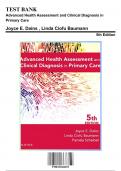Exam (elaborations)
Test Bank for Advanced Health Assessment and Clinical Diagnosis in Primary Care, 5th Edition by Dains, 9780323266253, Covering Chapters 1-41 | Includes Rationales
Test Bank for Advanced Health Assessment and Clinical Diagnosis in Primary Care, 5th Edition by Dains, 9780323266253, Covering Chapters 1-41 | Includes Rationales
[Show more]



